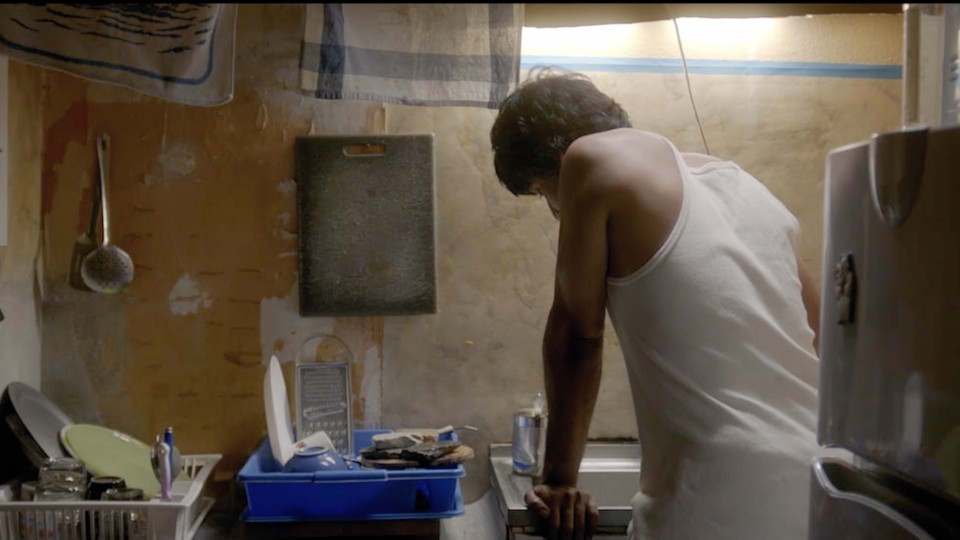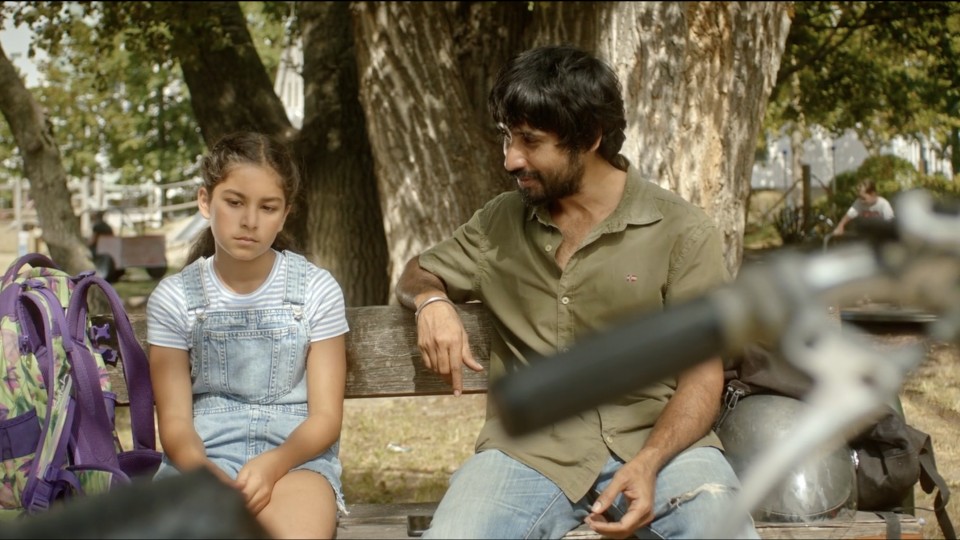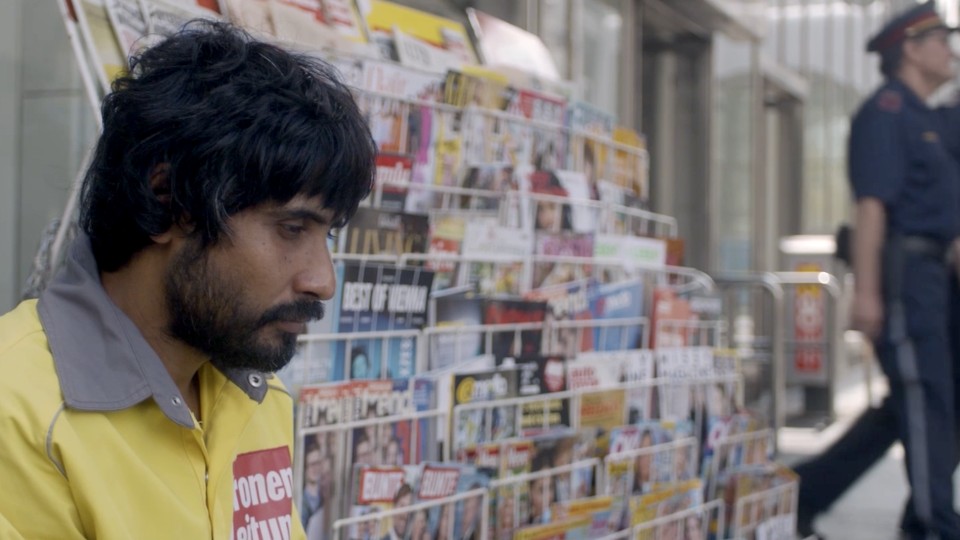Pittu, a traditional game where the aim is to knock down and quickly rebuild a wobbly tower made of seven stones, comes to
represent the rare but carefree encounters between Happy and his nine-year-old daughter. But the old Indian game also stands
for his situation in life as an asylum seeker in Vienna. Because even though he’s been in Austria for ten years now, he never
knows whether what has been built up today may not collapse again tomorrow. In HAPPY, Sandeep Kumar takes a look at the invisible existences of a city where life seems so simple.
Your feature film HAPPY focuses on an Indian migrant who has been in Austria for years without any legal status and lives
in constant fear of being deported. Did you feel it was important to focus on the individual fate of someone from an ethnic
group that isn’t at the centre of the asylum debate?
SANDEEP KUMAR: When I came to Austria almost 22 years ago, I noticed the Indian newspaper vendors. They were as much a part of the streetscape
of Vienna as the red trams. I've talked to many of them over the years. My first idea was to make a documentary about them,
because they’re invisible in this society. You just walk past them as if they were automatons, always standing there and working.
In HAPPY, these people's longing for a better life in a different country comes up against the strict asylum laws. I wanted
to put people's emotions in the foreground. I was concerned with the question: what’s the difference between me, with a piece
of paper that allows me to live here legally, and the people who work seven days a week for €1 an hour and have neither legal
status nor health insurance? I then deviated from the documentary idea as I started to focus on the emotional level. The real
story is in the individual fate. And if you appreciate the microcosm, the debate about the issue takes on a different quality
than if you discuss it at the level of laws.
You plunge into the realities of life in the Indian community in Vienna: precarious living conditions, cohesion, but at the
same time a lack of solidarity... Which aspects did you want to bring to the fore?
SANDEEP KUMAR: My film is an insight into a certain part of the community. There are several large groups: there are people from Punjab who
have opened restaurants and established themselves. The Sikhs comprise the largest community. There’s another from southern
India, consisting mainly of nurses who came in the 60s and 70s when there was no way into Eastern Europe. And then there are
the people who work in the diplomatic sector, for the UN; they usually only stay here for three years. The film is about the
people who are in the lowest class, who are also exploited by the wealthy Indian community for their own purposes. Deep down,
many of them are aware that they will never achieve legal status. It’s a film for an Austrian or European audience, but at
the same time it’s also aimed at India, because it shows clearly that the promises made to people who want to emigrate have
nothing to do with reality. The reasons people flee from India may be political, social or cultural. People sell all their
possessions – and then can't go back, because they've used up all their resources. They are victims who are exploited by the
smugglers.
To what extent is the film title to be appreciated in its ambiguity, as a name as well as a term for joy?
SANDEEP KUMAR: One thread running through the film is that everyone has a little bit of something that the other doesn't have. Whether it's
the Austrian asylum officer, the Romanian Dana, the Indian Happy... we are all entangled in a web where each of us lacks something.
One of my thoughts was to address, via a microcosm, a global topic: that humans can never be really happy because something
is always missing. In the end, you can ask yourself: who was really happy in the film?
The opening scene is a long sequence showing Happy meeting a government official, but we only see Happy’s face during the
dialogue, without cutting to reverse shots of the official. What made you decide to film these scenes only from this perspective?
SANDEEP KUMAR: I wanted the audience to be with Happy from the beginning and put themselves in his shoes. It’s the face you have to confront
all through the next 110 minutes. I didn't want people to be able to look away. Outside, it’s easy to look away. We look away
too much. A person goes to an appointment and is placed in a situation with no way out – and that now constitutes his fate.
I wanted to show that in real time. His situation is hopeless. I wanted people to empathize with that.
The leading role is played by Sahidur Rahaman, an actor from India who learned German for his role in HAPPY. How did the casting
come about? How did he prepare for the role?
SANDEEP KUMAR: I have to go back a bit. The first version of HAPPY came about in 2012. Shooting was finally planned for 2017, but it didn't
work out with the funding. So I made a different film and then came back to the script of HAPPY. I thought of this film as
my social obligation as a filmmaker. One big question was who would play the main character. We spent months looking for an
actor in the German-speaking world. People who were fine from the language perspective often weren’t so convincing from an
acting point of view. The character of Happy is in virtually every frame, so a lot depended on the actor playing him. Finally,
we summoned up our courage and took a risky decision; we started looking in Mumbai, with a casting director. That’s how we
found Sahidur Rahaman, who graduated from the National School of Drama, the best state drama school. He read the script and
was immediately keen on the part. We were also convinced by his audition videos. The only question mark was about his German.
We found a teacher in Mumbai who could give him a crash course. We couldn't offer him a reasonable fee, though we wanted to
take eight months of his time – but he agreed right away. On top of all that, it’s not easy to bring someone from India to
Europe. The visa only came through a week before we started filming. When our first face-to-face meeting took place, it was
still unclear whether he would speak the way we wanted him to. We didn't want High German from the Goethe Institute, so we
worked here with a language trainer to teach him the German you learn on the street, which is actually "bad". I wanted him
to communicate properly and not just memorize the dialogue phonetically. In addition, he also spent time with some newspaper
vendors.
Happy's fight for the right to stay is compounded by the fact that he has a nine-year-old daughter, Maya. She doesn’t have
an easy fate, either. What issues preoccupied you in telling the story of this father-daughter relationship?
SANDEEP KUMAR: I spent a long time trying to decide between a father/son or a father/daughter situation. Then the answer occurred to me quite
quickly. I have a son myself, and I always wanted to have a daughter, because it's a very special relationship. A daughter
always looks up to her father; he’s her first hero. But here we have a father who can’t offer his daughter any material things,
in comparison to her school friends. Nevertheless, Happy feels obliged to be there as a father figure and to offer her something,
at least until his possible deportation. He may only have a very short time to build up a relationship with her.
An important feature of the relationship between daughter and father is the Indian game Pittu. Can you outline for us what
it’s about? What does it mean for the two of them? Does the wobbly tower of stones have a symbolic meaning?
SANDEEP KUMAR: The game is the only thing Happy is very proud of, because he taught it to Maya. It’s called Pittu in northern India, it
is over 5000 years old, and it’s played in various parts of India and in Nepal. There are two teams. One team throws the ball
and knocks over the tower of stones, which it has to pile on top of each other again. The other team then gets the ball and
tries to hit the person who is rebuilding the tower. This is where the metaphorical meaning becomes apparent: when fate messes
up our lives, we don't have forever to put everything right again. And this doesn’t only apply to Happy. If you look at the
other characters in the film, they all have their worries and things that aren’t going according to plan. Maya has almost
nothing that her girlfriends have, but the game is something her friends don't share with their fathers. She will always remember
the game with her father.
Happy makes one of Maya's big wishes come true: to go by train to the mountains of Tyrol. The journey is on an old-fashioned
train with wooden benches. What prompted you to have their journey slip out of time and give it the dimension of a dream?
SANDEEP KUMAR: Happy put so much on the line to make that trip possible for Maya. I wanted the journey to appear almost like a dream. They
are both living an illusion, experiencing a beautiful side of life as a contrast to the rest of the film.
In the end, the two of them appear to escape reality – for a brief moment. The outlook isn’t exactly rosy, but it seems positive
right now. What food for thought would you like your audience to take away from the film?
SANDEEP KUMAR: I like films that provide an opportunity for an exchange of ideas afterwards. I want people to ask themselves: What happened
to Happy? And what about Maya? Why does a person have to lead a life like that? Every individual who comes into the world
wants a fulfilled life. Why is that impossible for so many people around us? And I’d like people to take a critical look inside
themselves. Shouldn't we be happy with what we already have? How many people aren’t even in touch with their parents, or their
children? Or can't live in freedom, without fear? Those are the subjects I want people to consider after seeing the film.
Interview: Karin Schiefer
October 2024
Translation: Charles Osborne









